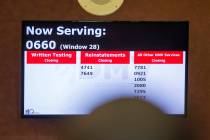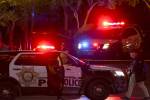Bus stop crash: Some tragedies can’t be prevented
When horrific tragedy strikes, grief and anger lead to questions and demands for solutions. How do we prevent senseless carnage and death?
Sometimes there isn't an answer.
Last week, the news from the intersection of Spring Mountain Road and Decatur Boulevard was so awful it seemed unbelievable. Just before 6:30 a.m. Thursday, a vehicle witnesses said was traveling 100 mph on eastbound Spring Mountain bottomed out crossing Decatur, spun out of control and rolled into the bus stop in front of the Carl's Jr. restaurant. The force and the result of the crash were staggering. Four people were killed at the scene and eight were seriously injured. An explosion might have caused less harm.
The driver, Gary Lee Hosey Jr., and four passengers in his vehicle had to be cut out of the smashed car. Hosey is scheduled to be arraigned Friday on four counts of felony driving under the influence causing death.
One person's poor decisions can lead to unimaginable damage. And yet the conversation following this accident immediately turned to the responsibility of the Regional Transportation Commission, the public agency that maintains the valley's bus stops.
In an email to the Review-Journal, Sandy Heverly, executive director of STOP DUI, said it's "important to have a conversation about what can be done to improve the safety of those shelters. ... There's no protection for these people. It's ridiculous."
People have died at valley bus stops before. They're exposed and close to the road. The RTC conducted a study about a decade ago to look for common denominators in bus stop deaths and identify possible faults with the stops. Carl Scarbrough, the transit amenities manager for the RTC, said the study identified a pattern: drivers breaking the law.
There are about 3,700 bus stops in the valley, and 1,600 of them are covered benches. New bus stops and those moved as a result of road improvements are set back farther from the street. Many of them have bus turnout lanes, which help traffic flow and passenger safety.
But most bus stops, like the one wiped out by Thursday's crash, are stuck. The RTC doesn't have the resources to purchase private land from neighborhoods and commercial properties to move thousands of stops farther from streets. And Ms. Heverly's well-intentioned suggestion to build steel and concrete barriers around bus stops is not only expensive, but likely wouldn't improve safety. Mr. Scarbrough notes that barriers are fine for low-speed crashes. But most vehicles that shoot past bus stops are traveling 40 to 60 mph. A driver who plows into such a barrier at high speed obliterates the car and the barrier, producing shrapnel.
Turning that Spring Mountain Road stop into a house might not have saved everyone. Such accidents are one in 10 million, the extremely rare exception to an otherwise safe transit system.
If property owners are willing to provide land to the RTC to move some bus stops back, they should engage the RTC. But no amount of money can guarantee the safety of every valley bus rider from a car traveling at an insanely fast speed.
Sometimes there isn't an answer.























